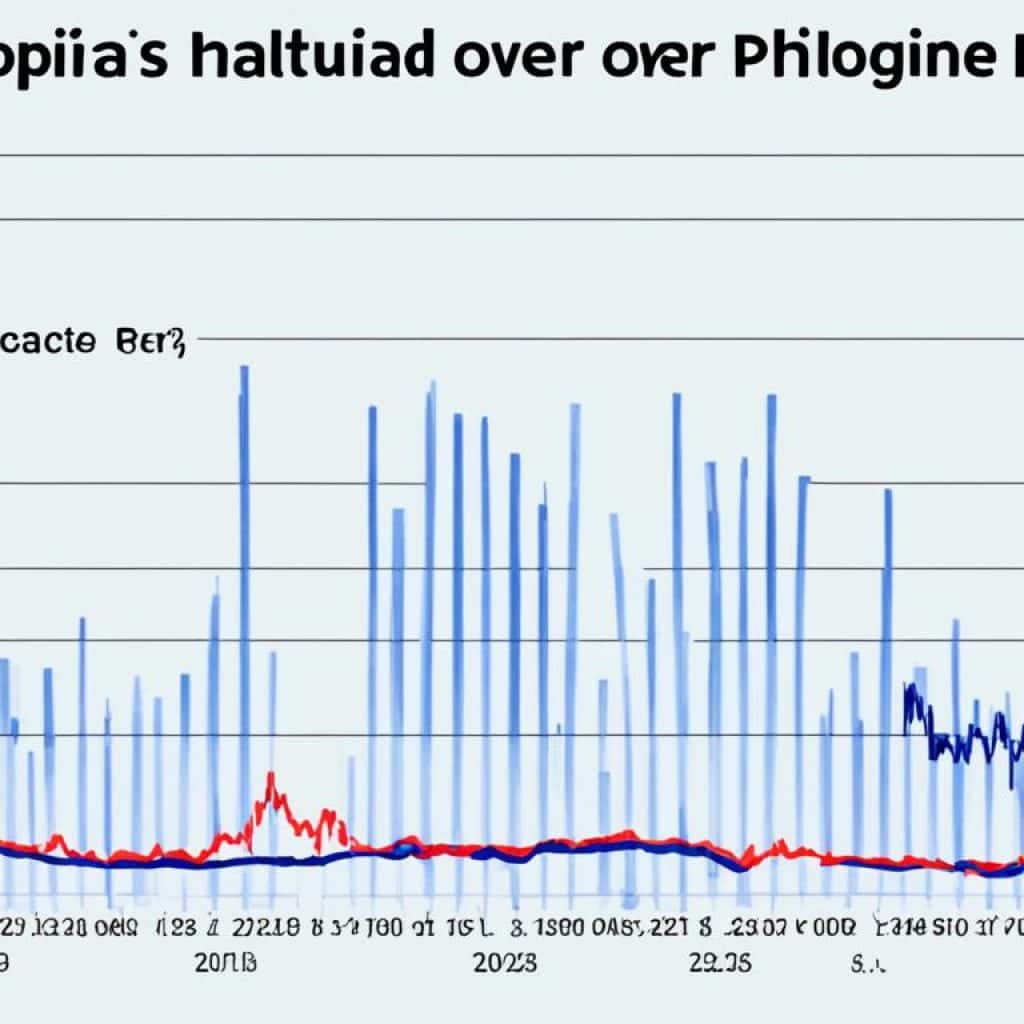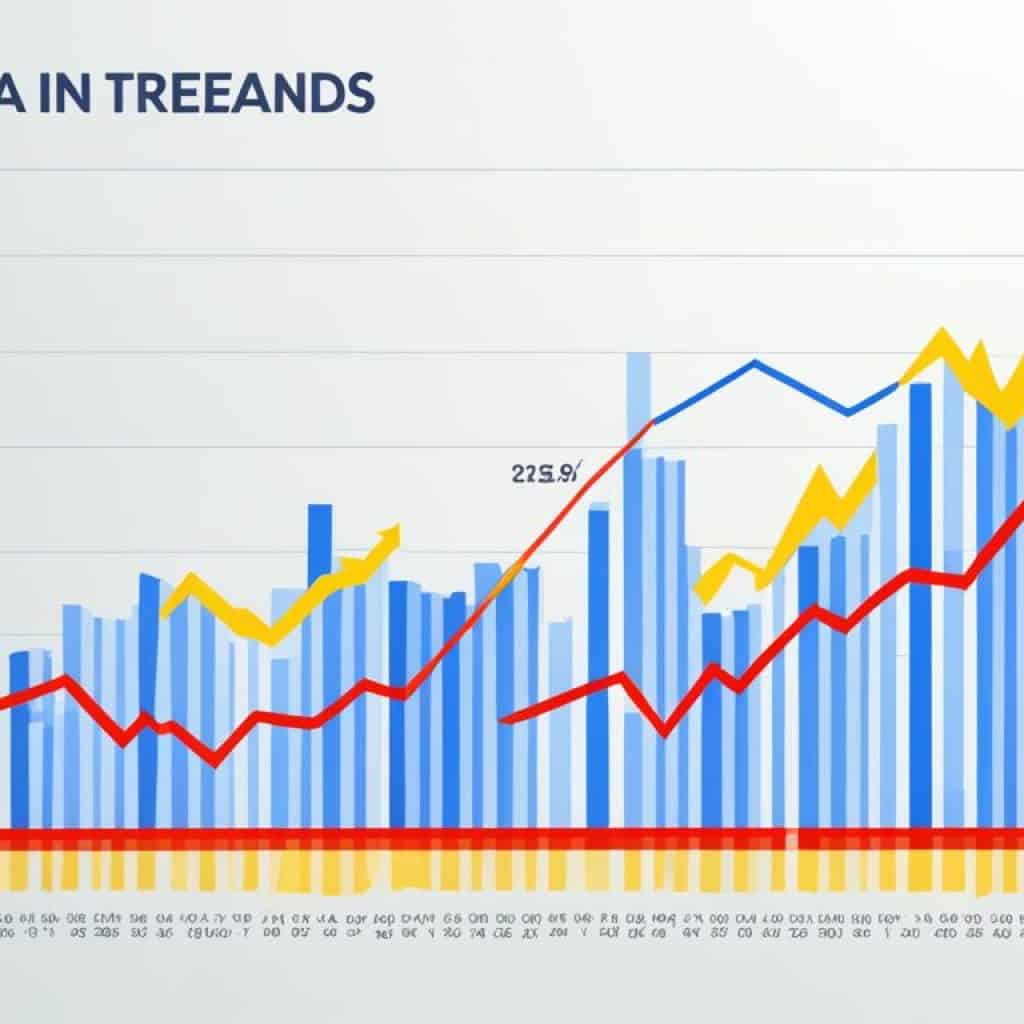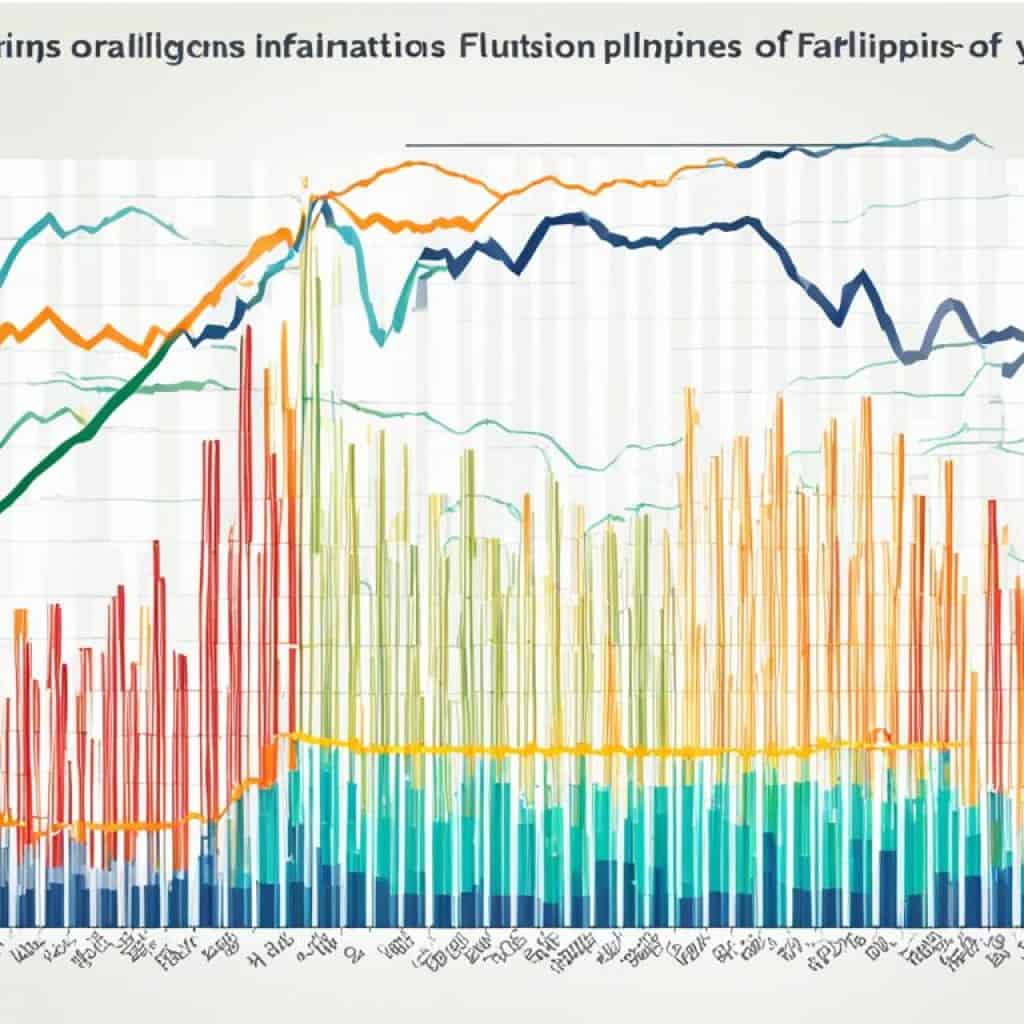Have you ever wondered about the factors driving the inflation rate in the Philippines? Is it influenced by food prices, housing costs, or transportation expenses? Understanding the trends and fluctuations of the Philippine inflation rate can provide valuable insights into the country’s economic landscape.
Recent data reveals that the annual inflation rate in the Philippines fell to 3.9% in December 2023. This marked the lowest reading since February 2022, with food prices rising the least in 19 months. Additionally, costs moderated for various categories, such as clothing, housing, utilities, and health. However, certain sectors, including alcoholic beverages and tobacco, education, and restaurants, experienced unchanged inflation rates.
Key Takeaways:
- The annual inflation rate in the Philippines dropped to 3.9% in December 2023, the lowest since February 2022.
- Food prices and various categories, including clothing and housing, contributed to the decline in inflation.
- Transport costs reversed their fall and registered a slight increase.
- The core inflation rate, excluding food and fuel, decreased to 4.4%.
- The outlook suggests that the inflation rate in the Philippines is expected to remain within the Central Bank’s target range in the coming months.
Overview of Inflation Rate in the Philippines
In December 2023, the inflation rate in the Philippines decreased to 3.90 percent from 4.10 percent in November. Over the period from 1958 to 2023, the average inflation rate in the Philippines was 8.07 percent, with a record high of 62.80 percent in September 1984 and a record low of -2.10 percent in January 1959. These statistics provide valuable insights into the historical and current inflation trends in the country.
The latest reported value for the Philippines’ inflation rate, along with previous releases, historical highs and lows, short-term forecasts, long-term predictions, economic calendar, survey consensus, and news can be found on this page. It serves as a comprehensive resource for understanding the inflation scenario in the Philippines.
“Understanding the inflation rate is crucial for making informed financial decisions.”
By monitoring and analyzing the inflation rate in the Philippines, individuals can anticipate and adapt to changes in the economy. Stay updated with the current inflation rate in the Philippines and take proactive measures to protect your finances and investments.
Forecast of Philippines' Inflation Rate
Inflation Rate in the Philippines is expected to be 3.20 percent by the end of this quarter, according to Trading Economics global macro models and analysts’ expectations. In the long-term, the Philippines Inflation Rate is projected to trend around 3.40 percent in 2025, according to our econometric models.

As per the forecast, the inflation rate in the Philippines is anticipated to remain stable in the coming months. This is encouraging news for the economy, indicating a positive outlook for price stability. It is important for individuals and businesses to stay informed about the projected inflation rate to make well-informed financial decisions.
Econometric models for inflation forecasting
Econometric models are statistical tools that analyze past data to predict future trends. These models take into account various factors such as economic indicators, monetary policies, and market conditions to estimate the future inflation rate. By utilizing a combination of historical data and current market conditions, analysts can make reliable predictions about the future inflation rate in the Philippines.
“Our econometric models suggest that the inflation rate in the Philippines will continue to hover around 3.20 percent in the short term. This indicates a stable inflation environment, which is beneficial for the overall economy.”
Factors influencing the forecast
Several factors contribute to the forecasted inflation rate in the Philippines. Key factors include government policies, global economic conditions, commodity prices, and consumer spending patterns. Additionally, the country’s monetary policies, such as interest rate adjustments and monetary stimulus measures, play a crucial role in managing inflation. By closely monitoring these factors, analysts can accurately predict the inflation rate and help individuals and businesses prepare for future economic conditions.
- Government policies
- Global economic conditions
- Commodity prices
- Consumer spending patterns
- Monetary policies
| Year | Inflation Rate |
|---|---|
| 2021 | 4.20% |
| 2022 | 3.80% |
| 2023 | 3.20% |
| 2024 | 3.40% |
| 2025 | 3.40% |
Note: The table above showcases the forecasted inflation rate in the Philippines for select years based on Trading Economics projections. Please keep in mind that these figures are subject to change as new data becomes available.
Consumer Price Index in the Philippines
The Consumer Price Index (CPI) is a key indicator that measures changes in the average retail prices paid by consumers for a basket of goods and services. In the Philippines, the CPI provides valuable insights into the cost of living and inflationary pressures faced by the population.
The most important categories in the Consumer Price Index in the Philippines include:
- Food and non-alcoholic beverages (39% of total weight)
- Housing, water, electricity, gas, and other fuels (22% of total weight)
- Transport (8% of total weight)
These categories have a significant impact on the overall CPI and reflect the expenses that consumers prioritize in their daily lives. Additionally, the index also considers the following sectors:
- Health (3% of total weight)
- Education (3% of total weight)
- Clothing and footwear (3% of total weight)
- Communication (2% of total weight)
- Recreation and culture (2% of total weight)
Together, these sectors account for a considerable portion of the price movements observed in the Consumer Price Index. Other goods and services, such as alcoholic beverages, tobacco, furnishing, household equipment, restaurants, and miscellaneous items, make up the remaining 15% of the index.
The Consumer Price Index in the Philippines provides essential information for policymakers, economists, and individuals to monitor price trends, assess inflationary pressures, and make informed decisions related to budgeting, financial planning, and investment strategies.
Ten-Year Average Inflation Rate in the Philippines
Over the past ten years, the Philippines has experienced an average consumer price inflation rate of 3.1%. This is higher than the average inflation rate of 2.1% in the Asia-Pacific region. In 2022, the Philippines recorded an average inflation rate of 5.8%, reflecting the economic dynamics and trends during that period.
Understanding the long-term average inflation rate is crucial for individuals and businesses alike. It provides insights into the country’s economic stability and influences financial planning decisions. By analyzing the ten-year average, one can gather valuable information to navigate market trends effectively.
In keeping with the need for a comprehensive understanding, let’s explore the historical and current inflation rate trends in the Philippines.
Philippine Inflation Rate Trends
The inflation rate in the Philippines has fluctuated over the years, impacted by various economic factors and government policies. While staying informed about the current inflation rate is essential, analyzing past trends provides a broader perspective.
Here is a summary of the Philippine inflation rate in recent years:
| Year | Inflation Rate |
|---|---|
| 2017 | 3.2% |
| 2018 | 5.2% |
| 2019 | 2.5% |
| 2020 | 2.6% |
| 2021 | 4.2% |
| 2022 | 5.8% |
As shown in the table above, the inflation rate in the Philippines has experienced both increases and decreases in recent years. This highlights the importance of closely monitoring inflation trends to make informed financial decisions.
Next, let’s explore the latest forecasts for the inflation rate in the Philippines to gain further insights into the country’s economic outlook.
Recent Trends in Inflation Rate in the Philippines
Inflation in the Philippines took a dip in December, reaching its lowest point in over a year. The rate dropped to 3.9% from November’s 4.1%, marking the lowest inflation rate since February 2022. This decline brought inflation back within the desired target range of 2.0-4.0% set by the Central Bank, a milestone not achieved since March 2022.
Notable factors influencing this trend include a decrease in price pressures for housing and utilities, as well as stable food prices. Additionally, transport costs experienced a rebound during this period. These developments indicate a positive shift in the overall inflation landscape in the Philippines.
As an annual average, inflation in December recorded a decrease to 6.0%. This serves as an encouraging sign of stability and provides a clearer picture of the country’s inflationary pressures.
| Category | November 2023 (%) | December 2023 (%) |
|---|---|---|
| Housing and Utilities | 2.5 | 1.5 |
| Food | 5.7 | 5.4 |
| Transport | -0.8 | 0.4 |
Source: Second Source
Outlook for Philippines' Inflation Rate
The Philippine inflation rate is expected to continue its disinflation trend for most of 2024, according to analysts. However, there may be some exceptions during the Apr-Jul period due to the adverse impact of El Nino and other price adjustments. Despite these fluctuations, the consensus forecast is for the inflation rate in the Philippines to remain within the Central Bank’s target range.
“The disinflation trend is likely to persist in the coming months, contributing to stable price levels. While certain factors may temporarily disrupt this trajectory, overall expectations align with the Central Bank’s inflation targets,” said [Name], an economist at [Financial Institution].
The forecasted stability in the inflation rate provides a positive outlook for the Philippine economy. It allows policymakers and consumers to make informed financial decisions and plan for the future. Monitoring inflation trends and staying updated on economic indicators will be essential in navigating the changing market conditions.

Factors Affecting Inflation Rate
Several key factors influence the inflation rate in the Philippines, including:
- Economic growth and demand for goods and services
- The cost of imported goods and raw materials
- Changes in government policies and regulations
- Global market trends and commodity prices
Understanding these factors and their potential impact on inflation can help individuals and businesses adapt their strategies and mitigate risks.
Comparison of Projected and Actual Inflation Rates
Table: Comparison of Projected and Actual Inflation Rates
| Year | Projected Inflation Rate | Actual Inflation Rate |
|---|---|---|
| 2022 | 3.5% | 5.8% |
| 2023 | 3.2% | 4.1% |
| 2024 | 3.4% | N/A |
Note: The projected inflation rates are based on the average forecasts of leading economists and financial institutions.
Consensus Forecasts and Projections for Philippines' Inflation Rate
As analysts and economists closely monitor the Philippine economy, projections and forecasts play a vital role in understanding the future trajectory of the inflation rate. FocusEconomics, a renowned economic research firm, collects forecasts from a panel of 32 experts focused on the Philippines. These forecasts are meticulously analyzed and averaged to provide a reliable and comprehensive projection for the Philippine inflation rate over the next ten years.
This collaborative approach ensures that a diverse range of perspectives and insights are taken into account, resulting in a more accurate forecast. It helps policymakers, businesses, and individuals make informed decisions and formulate strategies to navigate the changing economic landscape.
| Year | Inflation Rate Forecast (%) |
|---|---|
| 2024 | 3.2 |
| 2025 | 3.4 |
| 2026 | 3.5 |
| 2027 | 3.3 |
| 2028 | 3.1 |
| 2029 | 3.3 |
| 2030 | 3.4 |
| 2031 | 3.5 |
| 2032 | 3.2 |
| 2033 | 3.1 |
It’s crucial to note that these forecasts are subject to various factors that may influence the Philippine economy, such as global economic conditions, government policies, and unforeseen events. Therefore, continuous monitoring and regular updates are essential to stay informed about any potential changes in the inflation rate.
By relying on carefully collected and analyzed data, forecasts, and projections, individuals are better equipped to make proactive financial decisions, adapt to potential future economic trends, and navigate the opportunities and challenges that lie ahead.
Press Conference on the January 2024 Inflation in the Philippines
The Philippine Statistics Authority (PSA) recently conducted a press conference on the January 2024 Inflation Report. The press conference featured the National Statistician and Civil Registrar General as the resource person, providing valuable insights into the current state of inflation in the Philippines.
During the press conference, the highlights were shared live on the PSA’s official Twitter account and livestreamed on their Facebook page. This allowed the public to stay updated on the latest developments and gain a comprehensive understanding of the inflation rate in the Philippines.

By making this information accessible through digital platforms, the PSA aims to ensure transparency and promote financial literacy among the Filipino population. This initiative allows individuals to stay informed and make well-informed financial decisions based on the current inflation trends in the country.
Conclusion
The inflation rate in the Philippines decreased to 3.9% in December 2023, marking the lowest reading since February 2022. This decline was driven by moderating prices in several categories, including food, clothing, housing, utilities, and health. It is important for individuals to stay informed about inflation trends in the country to make proactive financial decisions.
Looking ahead, there are expectations that the inflation rate in the Philippines will remain within the Central Bank’s target range in the coming months. This provides some reassurance to consumers and businesses alike, as it signifies a level of stability in prices. However, it is still essential to monitor inflation closely and adapt financial strategies accordingly.
Understanding the fluctuations in the Philippine inflation rate allows individuals to plan their budgets more effectively and make informed investment choices. By staying updated on the latest developments and trends, individuals can mitigate the impact of inflation on their finances and ensure long-term financial well-being.
FAQ
What was the inflation rate in the Philippines in December 2023?
The inflation rate in the Philippines decreased to 3.9% in December 2023, the lowest reading since February 2022.
What were the main factors contributing to the decrease in inflation?
The decrease in inflation was primarily driven by the moderation in food prices, as well as lower costs for clothing, housing, utilities, furnishing, household maintenance, health, communication, recreation & culture, and miscellaneous items. However, inflation remained unchanged for alcoholic beverages & tobacco, education, and restaurants & accommodation. Transport costs also rose slightly.
What is the forecast for the Philippines’ inflation rate?
According to Trading Economics global macro models and analysts’ expectations, the inflation rate in the Philippines is expected to be 3.20 percent by the end of this quarter. In the long term, it is projected to trend around 3.40 percent in 2025.
Which categories have the highest weight in the Consumer Price Index (CPI) in the Philippines?
The most important categories in the Consumer Price Index (CPI) in the Philippines are food and non-alcoholic beverages, housing, water, electricity, gas, and other fuels, and transport. These three categories account for a significant portion of the total weight in the CPI.
What has been the average inflation rate in the Philippines in recent years?
Consumer price inflation in the Philippines has averaged 3.1% in the ten years up to 2022, which is higher than the Asia-Pacific regional average of 2.1%. The average figure for 2022 was 5.8%.
What are the recent trends in the inflation rate in the Philippines?
Inflation fell to over a one-year low in December 2023, with the rate decreasing to 3.9% from November’s 4.1%. This marked the lowest inflation rate since February 2022 and brought inflation back within the Central Bank’s target range of 2.0-4.0% for the first time since March 2022. Price pressures for housing and utilities declined, while food prices remained stable and transport costs rebounded. Annual average inflation also fell to 6.0% in December.
What is the outlook for the Philippines’ inflation rate?
Analysts maintain their view that the disinflation trend will continue through most of 2024, except for the Apr-Jul period due to the adverse impact of El Nino and other price adjustments. The expectation is for the inflation rate in the Philippines to remain within the Central Bank’s target range.
Are there any consensus forecasts and projections for the Philippines’ inflation rate?
Yes, FocusEconomics collects Philippine inflation projections for the next ten years from a panel of 32 analysts. These projections are averaged to provide a reliable forecast for Philippine inflation.
Was there a recent press conference on the January 2024 Inflation in the Philippines?
Yes, the Philippine Statistics Authority (PSA) conducted a press conference on the January 2024 Inflation Report, where the highlights of the report were shared live on the PSA’s Twitter account and livestreamed on their Facebook page.


















Add comment